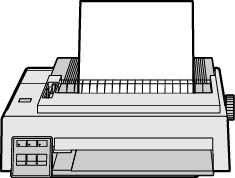The standard parallel port uses cable with a 25-pin female connector on one end and a Centronics-compatible D-Shell fitting on the other. You simply connect the Centronics-compatible end of the printer cable to the printer and attach the 25-pin plug to an LPT port on the computer. (Cables and connectors are discussed in detail later in Lesson 3.) Although parallel ports are relatively trouble-free, they have some disadvantages:
The data transfer rate is 150 KB. This is slow compared to network cards and other high-speed interfaces.
Parallel communication consumes system resources because it relies on the PC's system bus and CPU for transport and management.
There are no standards for parallel cables or ports. Although parallel port configurations follow a few common practices, this form of communication remains the source of compatibility problems.
Parallel cables usually have a maximum effective length of 10 feet. This can be extended by using a booster device, but at added cost.
Impact Printers
In the early days of PC printing, the most commons forms of printers were dot-matrix and daisy-wheel designs. Both these designs create an impression by striking an inked ribbon with enough force to place ink on the page. In this, they function very much like typewriters. Except for a few special cases, impact printers (one is shown in Figure 12.1) have been replaced by ink and laser technology.

Impact printer